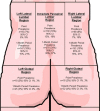Prevalence of low back pain by anatomic location and intensity in an occupational population
- PMID: 25146722
- PMCID: PMC4153910
- DOI: 10.1186/1471-2474-15-283
Prevalence of low back pain by anatomic location and intensity in an occupational population
Abstract
Background: Low Back Pain (LBP) is a common and costly problem, with variation in prevalence. Epidemiological reports of rating of pain intensity and location within the low back area are rare. The objective is to describe LBP in a large, multi-center, occupational cohort detailing both point and 1-month period prevalence of LBP by location and intensity measures at baseline.
Methods: In this cross-sectional report from a prospective cohort study, 828 participants were workers enrolled from 30 facilities performing a variety of manual material handling tasks. All participants underwent a structured interview detailing pain rating and location. Symptoms in the lower extremities, demographic and other data were collected. Body mass indices were measured. Outcomes are pain rating (0-10) in five defined lumbar back areas (i) LBP in the past month and (ii) LBP on the day of enrollment. Pain ratings were reported on a 0-10 scale and subsequently collapsed with ratings of 1-3, 4-6 and 7-10 classified as low, medium and high respectively.
Results: 172 (20.8%) and 364 (44.0%) of the 828 participants reported pain on the day of enrollment or within the past month, respectively. The most common area of LBP was in the immediate paraspinal area with 130 (75.6%) participants with point prevalence LBP and 278 (77.4%) with 1-month period prevalence reported having LBP in the immediate paraspinal area. Among those 364 reporting 1-month period prevalence pain, ratings varied widely with 116 (31.9%) reporting ratings classified as low, 170 (46.7%) medium and 78 (21.4%) providing high pain ratings in any location. Among the 278 reporting 1-month period prevalence pain in the immediate paraspinal area, 89 (32.0%) reported ratings classified as low, 129 (46.4%), medium and 60 (21.6%) high pain ratings.
Conclusions: Pain ratings varied widely, however less variability was seen in pain location, with immediate paraspinal region being the most common. Variations may suggest different etiological factors related to LBP. Aggregation of different locations of pain or different intensities of pain into one binary classification of LBP may result in loss of information which may potentially be useful in prevention or treatment of LBP.
Figures


Similar articles
-
Low-back pain ratings for lifetime, 1-month period, and point prevalences in a large occupational population.Hum Factors. 2014 Feb;56(1):86-97. doi: 10.1177/0018720813493641. Hum Factors. 2014. PMID: 24669545
-
The relationship of lumbar multifidus muscle morphology to previous, current, and future low back pain: a 9-year population-based prospective cohort study.Spine (Phila Pa 1976). 2014 Aug 1;39(17):1417-25. doi: 10.1097/BRS.0000000000000424. Spine (Phila Pa 1976). 2014. PMID: 24859576
-
Prevalence of and risk factors for different measures of low back pain among female nursing aides in Taiwanese nursing homes.BMC Musculoskelet Disord. 2007 Jun 25;8:52. doi: 10.1186/1471-2474-8-52. BMC Musculoskelet Disord. 2007. PMID: 17593305 Free PMC article.
-
The epidemiology of low back pain in chiropractors and chiropractic students: a systematic review of the literature.Chiropr Man Therap. 2024 Nov 26;32(1):36. doi: 10.1186/s12998-024-00559-8. Chiropr Man Therap. 2024. PMID: 39593163 Free PMC article.
-
Distribution and prevalence of musculoskeletal pain co-occurring with persistent low back pain: a systematic review.BMC Musculoskelet Disord. 2021 Jan 18;22(1):91. doi: 10.1186/s12891-020-03893-z. BMC Musculoskelet Disord. 2021. PMID: 33461514 Free PMC article.
Cited by
-
Which level is responsible for gluteal pain in lumbar disc hernia?BMC Musculoskelet Disord. 2016 Aug 22;17(1):356. doi: 10.1186/s12891-016-1204-7. BMC Musculoskelet Disord. 2016. PMID: 27550040 Free PMC article.
-
An Assessment of Nonoperative Management Strategies in a Herniated Lumbar Disc Population: Successes Versus Failures.Global Spine J. 2021 Sep;11(7):1054-1063. doi: 10.1177/2192568220936217. Epub 2020 Jul 7. Global Spine J. 2021. PMID: 32677528 Free PMC article.
-
Effectiveness of prevention exercises protocol among office workers with symptoms of carpal tunnel syndrome.Int J Occup Med Environ Health. 2024 Mar 5;37(1):45-57. doi: 10.13075/ijomeh.1896.02164. Epub 2024 Feb 9. Int J Occup Med Environ Health. 2024. PMID: 38362945 Free PMC article.
-
Exosomes for the Management of Low Back Pain: A Review of Current Clinical Evidence.Cureus. 2024 Apr 3;16(4):e57539. doi: 10.7759/cureus.57539. eCollection 2024 Apr. Cureus. 2024. PMID: 38707134 Free PMC article. Review.
-
Clinical Outcomes of Amniotic Membrane/Umbilical Cord Particulate in Spinal Disorders: A Retrospective Study.J Pain Res. 2022 Dec 16;15:3971-3979. doi: 10.2147/JPR.S375201. eCollection 2022. J Pain Res. 2022. PMID: 36561643 Free PMC article.
References
Pre-publication history
-
- The pre-publication history for this paper can be accessed here:http://www.biomedcentral.com/1471-2474/15/283/prepub
Publication types
MeSH terms
Grants and funding
LinkOut - more resources
Full Text Sources
Other Literature Sources
Medical
Miscellaneous

